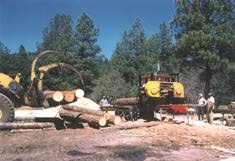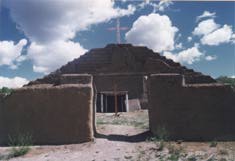 |
|
|
Volume III |
July 1999 |
Number VI |
|
|
Peñasco Grazing Workshop: Establishing Trust By Mark Schiller Puntos de Vista By George Maestas, Santa Barbara Grazing Permittee |
Vallecitos Sawmill at Work Photos by Claire Cummings Picuris Pueblo Nears Completion of San Lorenzo Mission Photos by Kay Matthews Editorial New Mexico Land Grant Forum Does Not Support Bingaman's Bill ALERT! |
Peñasco Grazing Workshop: Establishing TrustBy Mark SchillerOn June 6 members of the Santa Barbara Grazing Association, the Quivira Coalition, the Camino Real Ranger District and the Rio Pueblo/Rio Embudo Watershed Protection Coalition held a workshop to discuss how economically viable ranching and ecologically healthy rangeland can coexist. The workshop brought together members of the northern New Mexico ranching community, the Sierra Club, Audubon Society, New Mexico Green Party, BLM, Forest Service, National Parks Conservation Association, Taos Soil and Water, Taos Land Trust, Amigos Bravos, charitable trusts, and other interested individuals in an effort to initiate dialogue, create trust, and establish common goals. Virgil Trujillo, rangelands manager at Ghost Ranch, and a member of the Quivira Coalition Board of Directors, was the moderator, and gave a brief introductory presentation emphasizing the distinction between small-time family ranching, meant to put food on the table, supplement family income, and maintain traditional ties to the land, and big-time corporate ranching, which exploits both land and people. Andie Sanchez, President of the Santa Barbara Grazing Association, and George Maestas, a permittee on that allotment, then discussed some of the problems they are facing: loss of rangeland due to forest encroachment; lawsuits, which imperil grazing on public lands; and new regulations being imposed by the Forest Service. (Maestas' presentation is reproduced in our Puntos De Vista column on page 3). Next up was Palemon Martinez of the Northern New Mexico Stockman's Association. Martinez spoke about the role this group is trying to play in protecting and advancing the rights of stockmen. These include a proposed range management workshop on monitoring, investigating the grazing rights of Spanish and Mexican land grant heirs with regard to the provisions of the Treaty of Guadalupe Hidalgo, working with The Conservation Fund on the Rowe Mesa grassbank, and pursuing the Baca Ranch in the Jemez Valle Grande as another potential grass bank location. He also pointed out that forcing permittees off public lands will break these people's traditional ties to the land and ultimately could result in more development and the destruction of our rural/ agricultural communities. He asked the group, "Would you rather see 50 cows or 50 houses?" Dr. Craig Allen, an ecologist with the USGS, then gave a comprehensive presentation on the history of fire in the Jemez Mountains and its effect upon the grasslands. By studying the history of fire over hundreds of years and charting landscape changes over the last 55 years, as detected in aerial photographs, Allen has been able to determine that the montane grasslands, which have existed for thousands of years and are the most productive grasslands in the state, have steadily disappeared at the rate of about one per cent a year over the last 50 years. This has been due to the suppression of fire in these areas and the subsequent encroachment of ponderosa pine, Douglas fir and aspen. In an article in the May issue of the Quivira Coalition newsletter, he stated, "Similar tree and shrub invasions are also observed in many other open vegetation types throughout northern New Mexico. Many local forests, woodlands, and grasslands need to be restored to more open conditions to protect ecological values and human communities . . . . [G]enerally examples of ecologically appropriate restoration efforts include: cutting and burning trees out of invaded grasslands and meadows; thinning and prescribed burning on ponderosa pine forests to reduce the density of understory trees; and thinning younger piñon and juniper from thick woodlands . . . ." He goes on to say, " . . . [I]t is possible that the widespread restoration of enhanced grassy vegetation could help resolve persistent range management conflicts on public lands by providing additional grazing capacity on upland settings away from the environmental conflicts associated with grazing in riparian zones." Bill deBuys of The Conservation Fund then spoke about the grassbank his group is operating on Rowe Mesa near Pecos. The purpose of the grassbank is to provide year-round graze for up to 325 cattle from other national forest allotments which need to be upgraded. Permittees who take advantage of the program can place their cows on the ranch allotment for short or extended periods while they make efforts to upgrade "the capacity and vigor" of their own allotments. In this way permittees do not have to reduce the numbers of their cows and suffer the consequent economic hardships. Several permittees voiced interest in this program and a site visit is being planned. After lunch workshop participants, led by Camino Real biologist and range manager Ben Kuykendall, headed out to the Borrego area on US Hill where the Forest Service has implemented a thinning and burning project. Kuykendall showed participants how this combination has reduced the forest canopy and accumulated understory, thus stimulating the growth of native grasses and producing larger, healthier trees. This not only benefits grazing permittees but also increases biodiversity and produces cleaner, more abundant water. As a result of the workshop, organizers are now discussing the possibility of an on-the-ground project to demonstrate the effectiveness of these techniques and the cooperative efforts of ranchers, environmentalists, and public lands managers to, as Bill deBuys says, "work together for the good of the land and the people who depend on it. ANNOUNCEMENTS• The Camino Real Ranger District is proposing a wildfire protection and fuelwood project north of the village of El Valle on FR 207. According to the Forest Service, high density ponderosa, piñon, and juniper on ridges and ravines is causing an unhealthy watershed condition. The plan would include: 1) thinning for community fuelwood (4 to 6 weeks) and safety along FR 207; 2) reduce fuels to protect El Valle from wildfire danger; 3) achieve a stocking of large piñon nut producing trees; 4) correct erosion problems due to lack of ground vegetation by seeding native grasses; and 5) provide latillas and vigas. The project is consistent with the East Entrañas Ecosystem Management Unit of the Collaborative Stewardship Plan developed by local communities and various agencies. If you have any concerns or questions, please contact Carol Holland or Henry Lopez at P. O. Box 68, Peñasco, NM 87553 or call 587-2255. • Picuris Pueblo Environment Department, in conjunction with the Lannan Foundation, is sponsoring a Native American Permaculture Design Course from July 20 to July 31 at Picuris Pueblo. This 10-day intensive course will focus on land restoration, ecological design, home garden and backyard diversity, global community building, site analysis and landscape language, dry land strategies, seed saving, natural farming, solar energy systems, water harvesting, and water quality. For more information call Picuris Pueblo at 505-587-2519 or Traditional Native American Farmers Association at 505-983-2712. • The New Mexico Environment Department is sponsoring a workshop for watershed groups called the Confluence of Caretakers on July 25 at the Albuquerque Convention Center. The objective is to help organize and strengthen watershed groups, which have formed throughout the state to focus on issues of water quality and quantity; drinking water sources; recreation; the aquatic, riparian or uplands environment; irrigated agriculture or watering cattle; erosion control; flood control; land-use planning; land development and construction. The workshop will run all day and will address the following subjects: 1) history and hydrology of water in New Mexico; 2) practical tips on organizing local watershed groups; 3) watershed planning; 4) acequias; 5) how to work effectively with agencies and regulators; and 6) mediation, when and how. Please call Neal Shaeffer at the NMED for a complete agenda and to register for the workshop, which is free (including lunch): 505-827-5991. • This month La Jicarita expanded its free mailing to the village of Truchas. Soon we hope to also mail to all boxholders in the Dixon/Embudo area. The newspaper recently helped New Mexico win an informal contest in High Country News to determine which western state produces the best newsletters. Puntos de VistaBy George Maestas, Santa Barbara Grazing PermitteeMy name is George Maestas. I am a grazing permittee in the Santa Barbara Allotment of the Carson National Forest. When I was asked to come and speak to this group I was somewhat skeptical about how useful that might be, given the typical antagonistic relationship between ranchers and "environmental" groups. As I've learned more about the Quivira Coalition I've developed a more optimistic but still cautious outlook of the potential to work together. I'll try to explain a bit about why I was skeptical and about why I'm still cautious. I'll also try to focus on some of the issues that I believe are common interests to both our groups and on how we might be able to work together. As I said, my first reaction to this meeting was skepticism. This is born in the fact that almost weekly we hear about another lawsuit filed by some environmental group to try to eliminate or severely restrict grazing on our public lands. It seems that every week cattle and ranchers are blamed for some new environmental catastrophe. It's gotten to the point that I wouldn't be surprised to hear us blamed for problems with the Japanese economy or failure of the peace process in the Middle East. That's an exaggeration, of course, but the point is that our general impression is that for many environmental activists the end justifies the means. Their ultimate goal is to eliminate cattle grazing from public lands and the means to achieving that goal is to somehow link every environmental mishap or instance of range degradation to cattle. Some would have us believe that cattle and ranchers are the roots of all evil. In fact, our natural resources are under assault on a number of fronts. Recreational users, development interests, commercial and economic interests and even the activities of environmental activists can all adversely impact our natural resources. While it is true that cattle grazing undoubtedly affects the environment in a very direct (though not necessarily harmful) way, it is also true that ranchers have a very direct incentive to keep natural forage, and hence the environment in general, as healthy as possible. In the long term, a rancher's livelihood is directly linked to the productive capacity of the land. We have, over the long term, attempted to manage our grazing allotments so as to keep them healthy and productive. In my case, my grazing permits have been in my family for about 50 years. During that time, my family, my fellow permittees and I have conducted ourselves as stewards of the land. We have always understood that good quality rangeland will result in healthier, heavier stock, which is more profitable. Therefore, we have always promoted the range management practices believed to give the best quality and healthiest range. These management practices have evolved over time with different emphasis at different times, but the focus has always been on improvement. Many of the range improvement practices which were used in the past are no longer being allowed, often as a result of opposition by environmental activist groups. Logging, firewood gathering and burning, which were traditionally used to improve forage, are now either prohibited outright or extremely limited. In nature, fire is a natural and probably somewhat regular event. However, natural fires are seldom allowed to burn for long; instead, they are almost immediately extinguished. As a result of all these things, the forest continues to get denser and denser and the available grass forage is less and less. Also, grazing has been and continues to be pushed into more and more remote and often less productive areas to accommodate other uses such as recreation. Yet any damage done by some of those other users is still often attributed to cattle grazing. Seldom does anyone outside of the ranching community even recognize grazing as a legitimate use of public lands. But few have been as vocal as the so-called "environmentalists" have been in trying to force the outright elimination of grazing from public lands. I say so-called environmentalists because in my opinion they are often so intent on eliminating grazing that they have failed to consider the long term, big picture consequences of their "anti-grazing" blinders. In my opinion, the economic viability of our traditional communities is dependent on the continued availability of our forest lands for a variety of uses, including grazing. These traditional communities have helped preserve the environmental health of this area as compared to so many other areas in the country where development, recreation and large-scale economic interests like mineral extraction have laid waste to the environment. Having explained my skepticism, I am cautiously hopeful that the Quivira Coalition will live up to its billing - a billing that recognizes the value of traditional uses of the land, including grazing, and promotes improved range management practices. I am hopeful that you will, in fact, support our efforts to improve our range conditions. Most of all, however, I am hopeful that you will support grazing as a legitimate, environmentally benign use of public land. A voice of reason from an environmentally sensitive organization such as yours might go a long way toward real cooperation on the important issues of preserving our environment, our resources, and our way of life.
|
Vallecitos Sawmill at WorkPhotos by Claire CummingsFive employees of La Companía Ocho have been working at this sawmill site near the village of Vallecitos, milling sawtimber and peeling vigas. The timber, so far, is from the Jacques Tank sale. Ike DeVargas, La Companía founding member, hopes that with a $10,000 grant from the Forest Service and the return of a $5,000 performance bond the company will be able to buy a saw sharpener for the Heartwood Saw (pictured at right and below) that has been working overtime. Meanwhile, La Companía is preparing a work plan required for a funding proposal they will submit to the Northcentral Economic Development District. Several more sales are up and coming, and a skidder is removing trees along the La Manga sale right-of-way. Timber felled last year is decked (in good shape, with little blue stain) within the units already partially cut. The company would also like to purchase a planer and kiln drier to produce construction-grade lumber. The market for the rough-sawn wood they are producing at the site is soft: too many regulations prevent it from being marketed for mainstream construction. They have been selling to a door company in Santa Fe and to various other markets throughout the region. At this point, La Companía has more volume of timber than just about any other logging company in New Mexico.
Picuris Pueblo Nears Completion of San Lorenzo MissionPhotos by Kay MatthewsOn June 19 thirty-one volunteer workers were on hand to help apply the first coat of traditional mud plaster on San Lorenzo Mission at Picuris Pueblo. For eight years the pueblo has been working to restore the centuries-old church, and as San Lorenzo Feast Day (August 10) approaches, completion is in sight . On hand for the plastering were youth groups from Peñasco, tribal council members and village elders, under the direction of First Fiscale Clarence Chili (Second Fiscale is Luther Martinez). The original site of the mission church was across the road from the present location. The church at the present site was completed in 1751. After the building began to deteriorate, the Picuris Pueblo Restoration League was established in the 1980s, with Richard Mermejo as Chair, Gerald Naylor as Vice Chair, Tom Martinez as Secretary, and Carl Tsosie as Builder. During the last three years the church has been functional: the Matachines dance here at Christmas time, mass is celebrated once a month by Father Ortiz, and last year Archbishop Sheehan conducted mass on the feast day. Volunteers are always welcome to help with the restoration work. |
Home | Current Issue | Subscribe | About Us | Environmental Justice | Links | Archive | Index
Copyright 1996-2000 La Jicarita Box 6 El Valle Route, Chamisal, New Mexico 87521.




